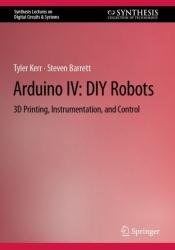Arduino IV: DIY Robots: 3D Printing, Instrumentation, and Control
- Добавил: literator
- Дата: 13-11-2022, 14:59
- Комментариев: 0
 Название: Arduino IV: DIY Robots: 3D Printing, Instrumentation, and Control
Название: Arduino IV: DIY Robots: 3D Printing, Instrumentation, and ControlАвтор: Tyler Kerr, Steven Barrett
Издательство: Springer
Год: 2022
Страниц: 243
Язык: английский
Формат: pdf (true)
Размер: 10.1 MB
This book is about the Arduino microcontroller and the Arduino concept. This book gives a step-by-step introduction to designing and building your own robots. As with other books in the Arduino series, the book begins with a quick overview of the Arduino Integrated Development Environment (IDE) used to write sketches, and the hardware systems aboard the Arduino UNO R3 and the Mega 2560 Rev 3. The level of the text makes it accessible for students, hobbyist and professionals' first introduction to both Arduino and Robotics.
This book will be accessible by all levels of students, advanced hobbyists and engineering professionals, whether using as a self-reference or within a structure design laboratory. The text then examines the many concepts and characteristics common to all robots. In addition, throughout the book , reasonably priced, easily accessible and available off-the-shelf robots are examined. Examples include wheeled robots, tracked robots and also a robotic arm.
After a thorough and easy to follow Arduino IDE and hardware introduction, the book launches into “do it yourself” or DIY concepts. A unique feature of the book is to start with a hands-on introduction to low cost 3D printing. These concepts will allow you to design and print your own custom robot parts and chassis. We then explore concepts to sense a robot's environment, move the robot about and provide a portable power source. We conclude with a several DIY robot projects.
This book is divided into a series of chapters to prepare you to design and build your own robots. The concepts provided may be used for small or large robots. As with other volumes in the series, Chap. 1 begins with a quick overview of the Arduino Integrated Development Environment (IDE) used to write sketches. We also explore hardware systems aboard the Arduino UNO R3 and the Mega 2560 Rev 3. The chapter concludes by exploring two off-the-shelf robots: the Dagu Rover 5 robot and the Tinkerkit Braccio Arduino robotic arm. We equip robots with additional features throughout the book. Central to our discussion of robots is the ability to design and fabricate custom robot parts and chassis. Chapter 2 provides instruction on low-cost 3D printing to allow custom fabrication of robot components.
In the next three chapters, we learn how to equip robots with sensors, a drive train, and a power source. Chapter 3 explores concepts to allow a robot to sense its location, avoid obstacles, and sense robot status and the surrounding environment. Chapter 4 explores different types of motors and actuators used aboard and to drive robots. We explore in detail how to interface and control high-power motors from a low-power microcontroller. Chapter 5 explores portable power sources for different robots. We explore different battery types and how to size a battery system for a specific application. In Chap. 6, we apply the book concepts to the design of a 4WD robot.
Скачать Arduino IV: DIY Robots: 3D Printing, Instrumentation, and Control
Внимание
Уважаемый посетитель, Вы зашли на сайт как незарегистрированный пользователь.
Мы рекомендуем Вам зарегистрироваться либо войти на сайт под своим именем.
Уважаемый посетитель, Вы зашли на сайт как незарегистрированный пользователь.
Мы рекомендуем Вам зарегистрироваться либо войти на сайт под своим именем.
Информация
Посетители, находящиеся в группе Гости, не могут оставлять комментарии к данной публикации.
Посетители, находящиеся в группе Гости, не могут оставлять комментарии к данной публикации.
